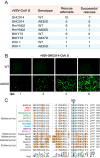Distinct pathways for evolution of enhanced receptor binding and cell entry in SARS-like bat coronaviruses
- PMID: 39546542
- PMCID: PMC11602109
- DOI: 10.1371/journal.ppat.1012704
Distinct pathways for evolution of enhanced receptor binding and cell entry in SARS-like bat coronaviruses
Abstract
Understanding the zoonotic risks posed by bat coronaviruses (CoVs) is critical for pandemic preparedness. Herein, we generated recombinant vesicular stomatitis viruses (rVSVs) bearing spikes from divergent bat CoVs to investigate their cell entry mechanisms. Unexpectedly, the successful recovery of rVSVs bearing the spike from SHC014-CoV, a SARS-like bat CoV, was associated with the acquisition of a novel substitution in the S2 fusion peptide-proximal region (FPPR). This substitution enhanced viral entry in both VSV and coronavirus contexts by increasing the availability of the spike receptor-binding domain to recognize its cellular receptor, ACE2. A second substitution in the S1 N-terminal domain, uncovered through the rescue and serial passage of a virus bearing the FPPR substitution, further enhanced spike:ACE2 interaction and viral entry. Our findings identify genetic pathways for adaptation by bat CoVs during spillover and host-to-host transmission, fitness trade-offs inherent to these pathways, and potential Achilles' heels that could be targeted with countermeasures.
Copyright: © 2024 Tse et al. This is an open access article distributed under the terms of the Creative Commons Attribution License, which permits unrestricted use, distribution, and reproduction in any medium, provided the original author and source are credited.
Conflict of interest statement
K.C. is a member of the scientific advisory board and holds shares in Integrum Scientific, LLC. K.C. is a cofounder of and holds shares in Eitr Biologics Inc.
Figures







Update of
-
Distinct pathway for evolution of enhanced receptor binding and cell entry in SARS-like bat coronaviruses.bioRxiv [Preprint]. 2024 Jul 13:2024.06.24.600393. doi: 10.1101/2024.06.24.600393. bioRxiv. 2024. Update in: PLoS Pathog. 2024 Nov 15;20(11):e1012704. doi: 10.1371/journal.ppat.1012704. PMID: 38979151 Free PMC article. Updated. Preprint.
References
MeSH terms
Substances
Grants and funding
LinkOut - more resources
Full Text Sources
Miscellaneous

